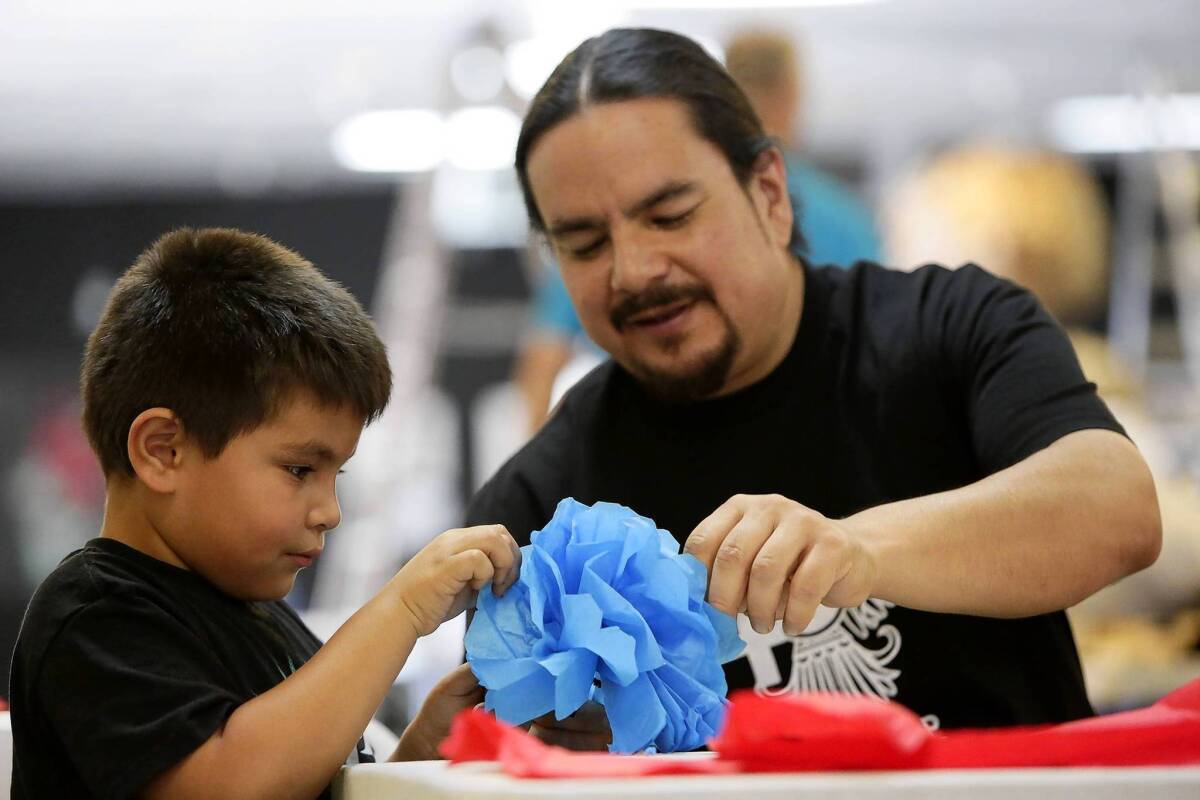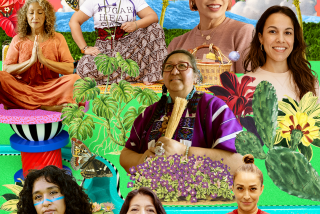Self Help Graphics & Art draws up big 40th-anniversary plans

As Gabriel Tenorio sat outside Self Help Graphics & Art one recent morning, painting fanciful faces on hollowed-out squashes and melons, his thoughts turned to death and rebirth.
Tenorio was among dozens of volunteers gathered to make Day of the Dead altars for Self Help’s popular neighborhood festival honoring ancestral spirits. Between their labors, volunteers sipped coffee and scarfed down hunks of fresh pan dulce. A recording by the genre-mashing L.A. band El-Haru Kuroi drifted from inside Self Help’s 3-year-old home, a remodeled former sea urchin packing plant on 1st Street in Boyle Heights across from a Metro Gold Line station.
“These are dried-out gourds that now have a new life,” said Tenorio, an artist, musician and former interim director of Self Help during some of the darkest days of its 40-year history.
PHOTOS: Arts and culture in pictures by The Times
Much the same could be said of Self Help, one of the most influential and enduring cultural enterprises to emerge from the Chicano self-empowerment movement of the 1970s. Eight years ago, Self Help seemingly had one foot in the grave and the other on a plátano peel. Beset by financial shortfalls and staff layoffs, with a leaky building and sagging morale, the “artist-driven, social justice-based” workshop and community cultural center was briefly forced to padlock its doors.
But this year, marking its four-decade anniversary, Self Help appears to have resurrected itself. Its budget, which plummeted from $708,000 in 2002 to $231,000 in 2007, has rebounded to about $380,000, said Evonne Gallardo, the center’s executive director since 2009. From a skeletal staff of two full-time workers in the mid-2000s, Self Help has grown to four full-time employees and roughly a dozen contracted artists, with about 50 affiliated artists in total.
Over the coming months, Self Help will be exploring its 40 years of existence and mapping its future with exhibitions, workshops, round-table discussions and other events.
“We feel like a small start-up. I think it’s an exciting position,” said Gallardo, an East L.A. native who previously worked with LACMA Director Michael Govan when he ran the Dia Art Foundation in New York. She’s also a flamenco dancer.
“I can’t paint or draw for a lick, but I know that feeling of the creative process,” Gallardo said with a laugh.
Comparing Self Help to a band of Silicon Valley garage entrepreneurs may raise eyebrows, but it suggests the ambitious vision of Gallardo and her board of directors.
While keeping faith with its Latino roots, Self Help is seeking to broaden its identity to reflect the city’s evolving demographics. While preserving its artistic origins as a print-making and art-production center, Self Help also aims to branch into creative technologies directed at a generation that lives on hand-held devices and gravitates more toward conceptual art, performance art, digital graphic design and sticker and skateboard art than it does to serigraphs.
ART: Can you guess the high price?
Like their predecessors, some of these young artists are painting murals and making silk-screens, but they’re also fabricating miniature digital art galleries on Flickr and Instagram.
“There is an opportunity to unpack what’s been going on with artists in the past 15 years,” Gallardo said. “Generation X and Generation Y artists kind of got, not ignored purposefully, but just kind of like there were other things on the table at the time.”
Two second-generation artists, Dewey Tafoya and Becky Cortez, were among the Day of the Dead altar-making volunteers. Tafoya, 40, offered a visitor a tour of his temporary studio at Self Help, where he is a resident artist. Occupying a former refrigeration room, the studio now holds a T-shirt printing machine and samples of poster designs Tafoya made with UCLA students for an HIV-prevention awareness campaign.
Asked how he joined the Self Help community, Tafoya replied, “I think it’s one of those things where the name kind of speaks for itself: Self Help. I think anyone has that chance if they’re willing to work in an environment where everybody else is working. Because a lot of artists want to hide themselves away.”
Cortez, also 40, who was helping young students to make masks, said that the exchange of knowledge and creative passions between Self Help’s elder and younger artists is mutually beneficial. “Our generation was just so much more removed from the handmade and crafts,” she said.
Self Help arose at a time when Chicano artists had few outlets for their work and were largely ignored by most museums and commercial galleries. For decades it was overseen by its founder, the chain-smoking, tough-minded Franciscan nun Sister Karen Boccalero, a painter and silk-screen artist who started working with East L.A. artists out of the garage behind the home she shared with other nuns.
Under her guidance, Self Help nurtured a generation of young artists, including John Valadez, Frank Romero, Judithe Hernández, Gronk, Patssi Valdez and Jose Lozano, who forged an iconography of Chicano art and went on to have international careers.
After Boccalero’s death in 1997, Self Help struggled to reorder its financial house and chart a new course for advancing its mission of “social change through art.” At the same time, it was undergoing a generational turnover. “A couple generations of artists felt that this was really theirs, and there was, I think, a hard transition to letting go,” Tenorio said.
In moving forward, Gallardo wants Self Help to maintain its legacy while “continuing trying to be innovative.” That means preserving traditions like the Día de los Muertos celebration, and retro-fitting the Barrio Mobile Art Studio, which the organization is reviving with a two-year, $80,000 James Irvine Foundation grant. The traveling print-making studio, which Self Help launched in 1974, has been on hiatus in recent years.
But in the next couple of months, Self Help plans to buy and customize a new trailer that will zip around L.A. offering workshops in print-making and mobile-phone art to high schools, colleges, community-based organizations and a handful of corporate clients. The initiative will provide a new revenue stream to augment the money Self Help gets from print sales, fundraising events and corporation and foundation support, which has taken a hit during the Great Recession.
Self Help’s physical relocation also has inspired the nonprofit to rethink priorities. Its new single-story headquarters, with 13,500 square feet of space, is nearly as large and functionally more practical than its beloved, tile-clad former home at Cesar Chavez and Gage avenues. Self Help had occupied that site for 30-plus years, rent-free, until Boccalero’s Franciscan order, the Sisters of St. Francis, lost faith that the beleaguered institution would be able to regroup and sold the building to a private investment firm.
The new structure sits strategically at the western fringes of the burgeoning Boyle Heights arts district, which enfolds programmatically bold venues such as Eastside Luv bar, the eclectic Espacio 1839 music and accessories store, Corazon Del Pueblo arts and education center and Casa 0101 theater.
“We were on an island before,” said board member Valarie de la Garza. The move, she continued, has “put us in a different situation where we need to evaluate what we should be doing and not doing.”
One upcoming exhibition in particular may encapsulate that process. For several months, a small group of affiliated artists and staffers have been combing Self Help’s collection of hundreds of prints, trying to choose 40 “germinal” works that will narrate the organization’s 40-year journey and showcase its artistic range. A May exhibition is planned.
It’s part of what board member Karen Mary Davalos calls “remixing” the print collection and re-contextualizing it for a new era. Meanwhile, Jose “Joe” Alpuche, Self Help’s longtime master printer, said he’s enjoying collaborating with young digital-age artists who may never have made a print before.
“They may be a little skeptical at the beginning, but once they start seeing the process they get so inspired and hungry for more,” he said. “And being able to see young people coming on board with fresh ideas keeps me fresh too.”
More to Read
The biggest entertainment stories
Get our big stories about Hollywood, film, television, music, arts, culture and more right in your inbox as soon as they publish.
You may occasionally receive promotional content from the Los Angeles Times.











